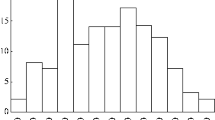Summary
Acoustic signals (10–100 msec, 5kHz, 70 or 80 dB) have an inhibitory effect on chirping in the cricketGryllus campestris L. After a reaction time of approximately 50 msec there is a period of about 150 msec (at 27 °C) during which it is very unlikely that a chirp will begin. The effect is not abolished by removal of the tympanal organs, antennae and cerci. Electrophysiological recordings made from the neck connectives in freely moving insects show that tympanal ablation does not abolish sound reception.
Similar content being viewed by others
References
Autrum, H.: Über Gehör- und Erschütterungssinn bei Locustiden. Z. vergl. Physiol.28, 580–637 (1941)
Baier, L. F.: Contribution to the physiology of the stridulation and hearing of insects. Zool. Jb.47, 151–248 (1930)
Dambach, M.: Ein auf Substratvibration reagierendes Interneuron im Bauchmark der Grille. Z. vergl. Physiol.70, 57–61 (1970)
Dambach, M.: Der Vibrationssinn der Grillen. I. Schwellenmessungen an Beinen frei beweglicher Tiere. II. Antworten von Neuronen im Bauchmark. J. comp. Physiol.79, 281–324 (1972)
Fulton, B. B.: A demonstration of the location of auditory organs in certain Orthoptera. Ann. ent. Soc. Amer.21, 445–448 (1928)
Heiligenberg, W.: The stimulation of territorial singing in house crickets (Acheta domesticus). Z. vergl. Physiol.53, 114–129 (1966)
Heiligenberg, W.: The effect of stimulus chirps on a cricket's chirping (Acheta domesticus). Z. vergl. Physiol.65, 70–97 (1969)
Jones, M. D. R.: The acoustic behaviour of the bush cricketPholidoptera griseoaptera. I. Alternation synchronism and rivalry between males. J. exp. Biol.45, 15–30 (1966a)
Jones, M. D. R.: The acoustic behaviour of the bush cricketPhilidoptera griseoaptera. 2. Interaction with artificial sound signals. J. exp. Biol.45, 31–44 (1966b)
Jones, M. D. R.: The effect of acoustic signals on the chirp rhythm in the bush cricketPholidoptera griseoaptera (1973, in preparation).
Kutsch, W.: Neuromuskuläre Aktivität bei verschiedenen Verhaltensweisen von drei Grillenarten. Z. vergl. Physiol.63, 335–378 (1969)
Nocke, H.: Physiological aspects of sound communication in crickets (Gryllus campestris L.). J. comp. Physiol.80, 141–162 (1972)
Phillips, L. H., Konishi, M.: Control of aggression by singing in crickets. Nature (Lond.)241, 64–65 (1973)
Regen, J.: Das tympanale Sinnesorgan vonThamnotrizon apterus Fab. (Männchen) als Gehörapparat experimentell nachgewiesen. S.B. Akad. Wiss. Wien117, 487–490 (1908)
Regen, J.: Über die Orientierung des Weibchens vonLiogryllus campestris L. nach dem Stridulationsschall des Männchens. S.B. Akad. Wiss. Wien132, 81–88 (1923)
Shaw, K. C.: An analysis of the phonoresponse of males of the true Katydid,Pterophylla camellifolia (Fabricius). Behaviour31, 203–260 (1968)
Wever, E. G., Vernon, J. A.: The auditory sensitivity of Orthoptera. Proc. nat. Acad. Sci. (Wash.)45, 413–419 (1959)
Author information
Authors and Affiliations
Rights and permissions
About this article
Cite this article
Jones, M.D.R., Dambach, M. Response to sound in crickets without tympanal organs (Gryllus campestris L.). J. Comp. Physiol. 87, 89–98 (1973). https://doi.org/10.1007/BF00699298
Received:
Issue Date:
DOI: https://doi.org/10.1007/BF00699298




